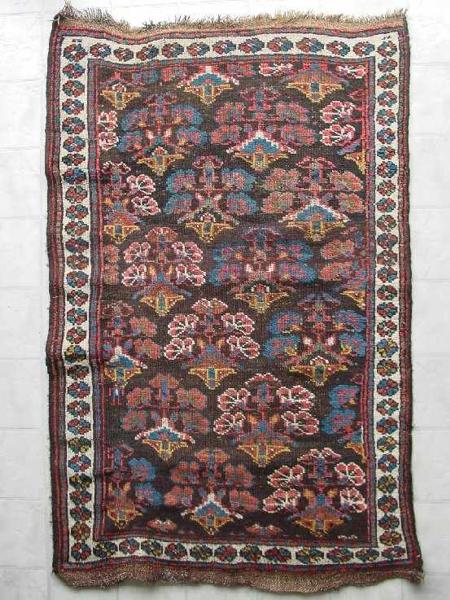
The Salon du Tapis d'Orient is a moderated discussion group in the manner of the 19th century salon devoted to oriental rugs and textiles and all aspects of their appreciation. Please include your full name and e-mail address in your posting.
Part 3: Alluring Luris, Denizens of the Zagros
by Patrick Weiler
Here is a rug that seems to meet all the criteria for a Luri rug.

It has warps of dark brown and light brown or mixed dark and white or mixed dark and light brown wool. There are two shots of light brown or dark brown wool wefts. It has a low knot count, 6h x 8v for 48 per square inch. The warp is flat or moderately depressed. The selvage is two cords of two warps overcast with goat hair. The bottom kilim end has a stripe of extra-weft patterning consisting of red alternating with white over-four-under-four. The top has a similar stripe of red alternating with blue. There are 9 colors, including dark and light brown, black, white, yellow, green, blue, red and brick.
Here are two photos of one corner, front and back.
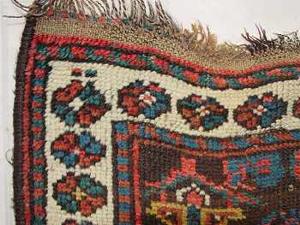
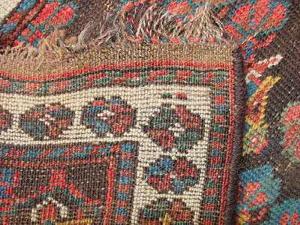
This is a close-up of the little Lur guy, with a very large Luri nose.
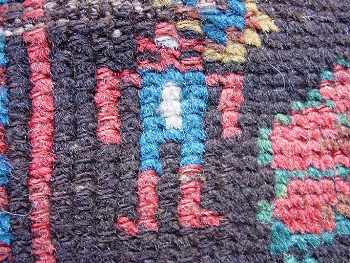
The only problem is that it is a mere 30” wide x 49” long (77cm x 125cm)! Is this a Missing Luri Link? An atypical aberration? A one-off oddity? It is the size of an engsi, or prayer rug, but has all the other characteristics of a Luri rug. Is it unique? Or are there numerous rugs like this that have just not been identified as Luri?
Why are there numerous dated and inscribed Bakhtiyari rugs but few or no inscribed Luri rugs? Is it because we label the finer, more cosmopolitan rugs Bakhtiyari and the more rustic rugs Luri, even if they were woven by the same tribe?
What rugs and bags do you have that may be Luri after all, and NOT the more famous Qashqai, Khamseh, Caucasian or Kurd?
And finally, a most intriguing picture of my license plate.
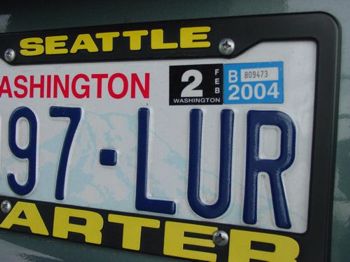
Coincidence?
Bibliography
1. Edwards, Cecil, The Persian Carpet 1953
2. Housego, Jenny, Tribal Rugs
3. Burns, James D., Antique Rugs of Kurdistan, pages 306 and 313
4. Oriental Rug Review, volume 12, number 4, April/May 1992
5. http://www.Mydictionary.com
6. http://www.Zoroastriankids.com
7. Oriental Rug Review, Volume 11/3, http://www.rugreview.com/122a1.htm
8.
Hull and Luczyc-Wyhowska, Kilim, The Complete Guide
9. Porada, Edith [With the collaboration of R. H. Dyson and contributions
by C.K. Wilkinson]. The Art of Ancient Iran, Pre-Islamic Cultures http://www.noteaccess.com/Texts/Porada/6.htm,
10. Oriental Rug Review volume 11, number 5, June/July 1991
11. The Columbia Encyclopedia, Sixth Edition. 2001 http://www.bartleby.com/65/lo/Lorestan.html
12. Oriental Rug Review, Vol 14, No. 6 (Aug/Sept, 1994);
http://www.ne-rugsociety.org/orr-literature/bakhtiyari-motifs.htm
13. Black and Loveless, Woven Gardens
14. MacDonald, Brian, Tribal Rugs, Treasures of the Black Tent
16. Eiland, Murray L., Jr. and Eiland, Murray III, Oriental Carpets,
A Complete Guide
17. http://www.jozan.com/English_version/articles_en/DannyMehraCollection.htm
18. Opie, James, Tribal Rugs
19. Oriental Rug Review, volume 9, #6, August/September 1989
20. de Franchis, Amedeo and Wertime, John, Lori and Bakhtiyari
Flatweaves
21. Mallett, Marla, Woven Structures (used for structural
analysis)
22. http://www.chromosome5.com/
23. http://www.afro-dit.com
24. Philadelphia Rug Society, http://www.geocities.com/jbulyk/luri_f1.jpg